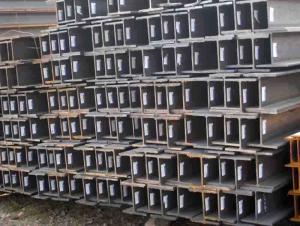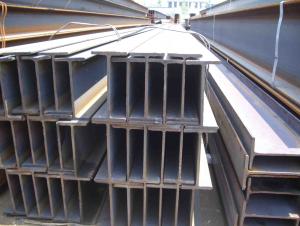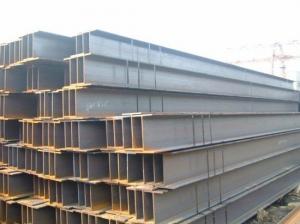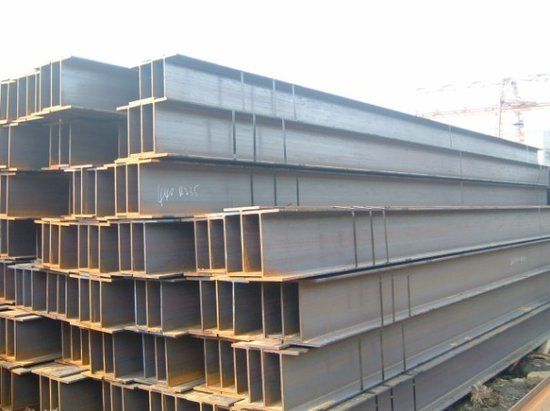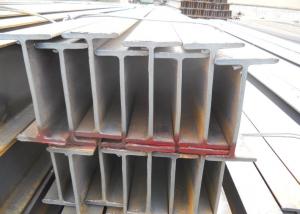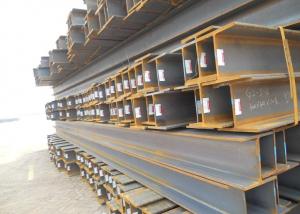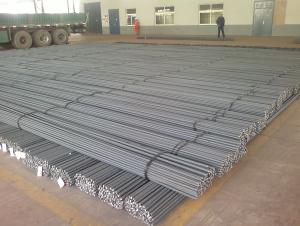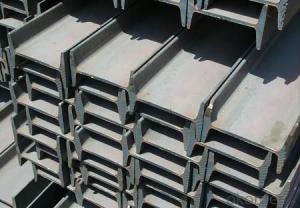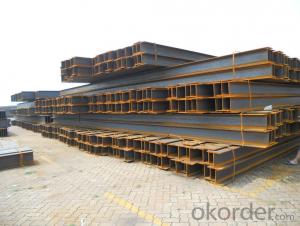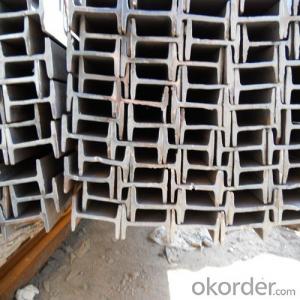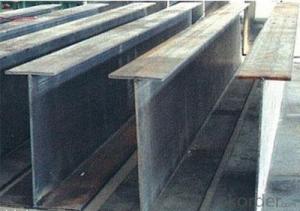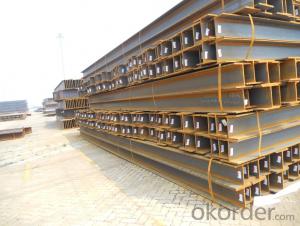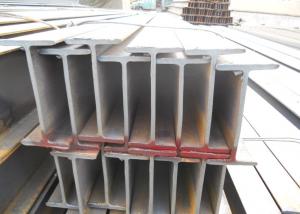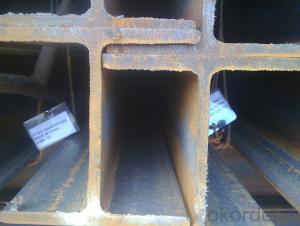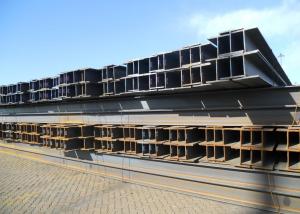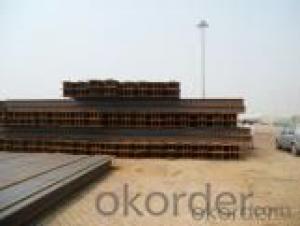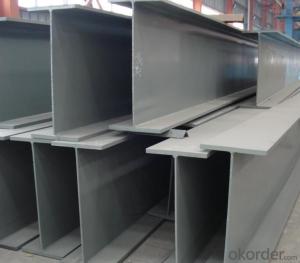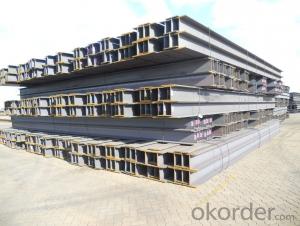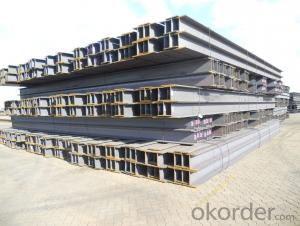Hot Rolled Steel H Beams for Steel Structure
- Loading Port:
- China Main Port
- Payment Terms:
- TT or LC
- Min Order Qty:
- 100 m.t.
- Supply Capability:
- 10000 m.t./month
OKorder Service Pledge
OKorder Financial Service
You Might Also Like
Product Description:
OKorder is offering Hot Rolled Steel H Beams for Steel Structure at great prices with worldwide shipping. Our supplier is a world-class manufacturer of steel, with our products utilized the world over. OKorder annually supplies products to African, South American and Asian markets. We provide quotations within 24 hours of receiving an inquiry and guarantee competitive prices.
Product Applications:
Hot Rolled Steel H Beams for Steel Structure are ideal for structural applications and are widely used inindustrial plants, civil construction, municipal works, oil platforms, bridges, flatbed beams, electrified railway power stand, railway bridges and other light steel structure, super-light H-beam is ideal for containers, mobile homes , all kinds of garage, box-type trains, electrical bracket, various venues, small villa manufacturing etc.
Product Advantages:
OKorder's Hot Rolled Steel H Beams for Steel Structure are durable, strong, and wide variety of sizes.
Main Product Features:
· Premium quality
· Prompt delivery & seaworthy packing (30 days after receiving deposit)
· Can be recycled and reused
· Mill test certification
· Professional Service
· Competitive pricing
Product Specifications:
Manufacture: Hot rolled
Grade: Q195 – 235
Certificates: ISO, SGS, BV, CIQ
Length: 12m, as per customer request
Packaging: Export packing, nude packing, bundled
| H BEAM | ||||||
| size | h (MM) | b (MM) | t1 (MM) | t2 (MM) | Mass: Kg/m | LENGTH |
| 100x100 | 100 | 100 | 6.0 | 8 | 16.9 | 12M |
| 125x125 | 125 | 125 | 6.5 | 9 | 23.6 | 12M |
| 150x75 | 150 | 75 | 5.0 | 7 | 14.0 | 12M |
| 148x100 | 148 | 100 | 6.0 | 9 | 20.7 | 12M |
| 150x150 | 150 | 150 | 7.0 | 10 | 31.1 | 12M |
| 175x90 | 175 | 90 | 5.0 | 8 | 18.0 | 12M |
| 175x175 | 175 | 175 | 5.0 | 11 | 40.4 | 12M |
| 198x99 | 198 | 99 | 4.5 | 7 | 17.8 | 12M |
| 200x100 | 200 | 100 | 5.5 | 8 | 20.9 | 12M |
| 194x150 | 194 | 150 | 6.0 | 9 | 29.9 | 12M |
| 200x200 | 200 | 200 | 8.0 | 12 | 49.9 | 12M |
| 200x204 | 200 | 204 | 12.0 | 12 | 56.2 | 12M |
| 248x124 | 248 | 124 | 5.0 | 8 | 25.1 | 12M |
| 250x125 | 250 | 125 | 6.0 | 9 | 29.0 | 12M |
| 244x175 | 244 | 175 | 7.0 | 11 | 43.6 | 12M |
| 250x250 | 250 | 250 | 9.0 | 14 | 71.8 | 12M |
| 250x255 | 250 | 255 | 14.0 | 14 | 81.6 | 12M |
| 298x149 | 298 | 149 | 5.5 | 8 | 32.0 | 12M |
| 300x150 | 300 | 150 | 6.5 | 9 | 36.7 | 12M |
FAQ:
Q1: Why buy Materials & Equipment from OKorder.com?
A1: All products offered byOKorder.com are carefully selected from China's most reliable manufacturing enterprises. Through its ISO certifications, OKorder.com adheres to the highest standards and a commitment to supply chain safety and customer satisfaction.
Q2: How many tons of steel products could be loaded in containers?
A2: Usually the steel products are delivered by bulk vessel because of the large quantity and the freight. However, there are no bulk vessel enter some seaports so that we have to deliver the cargo by containers. The 6m steel product can be loaded in 20FT container, but the quantity is changed according to the size, usually from 18tons to 25tons.
Q3: How soon can we receive the product after purchase?
A3: Within three days of placing an order, we will arrange production. The normal sizes with the normal grade can be produced within one month. The specific shipping date is dependent upon international and government factors, the delivery to international main port about 45-60days.
Images:
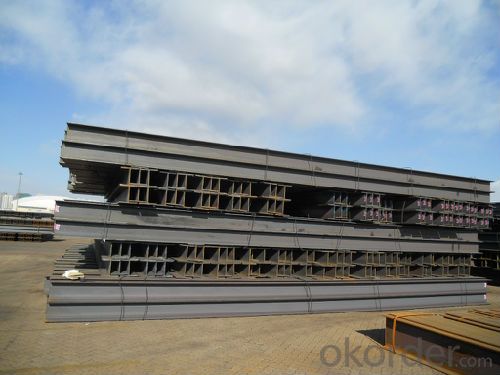
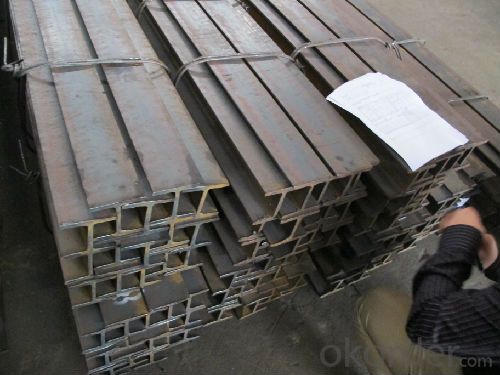
- Q: What are the common fabrication techniques used for steel H-beams?
- The common fabrication techniques used for steel H-beams include hot rolling, welding, and cutting.
- Q: How do steel H-beams perform in bridge expansions or contractions?
- Steel H-beams are widely used in bridge construction due to their excellent performance during expansions or contractions. These beams have high tensile strength and flexibility, allowing them to withstand the forces caused by temperature variations. As the bridge expands or contracts due to temperature changes, the steel H-beams can adjust their shape accordingly without compromising the structural integrity of the bridge. This ability to accommodate thermal movements makes steel H-beams an ideal choice for bridges, ensuring their stability and longevity over time.
- Q: What are the different finishes available for Steel H-Beams, such as galvanized or painted?
- The different finishes available for Steel H-Beams include galvanized, painted, and untreated/raw. Galvanized beams are coated with a layer of zinc to protect against corrosion, while painted beams are coated with a layer of paint for aesthetic purposes and added protection. Untreated/raw beams do not have any additional coatings or finishes applied to them.
- Q: What are the common design mistakes to avoid when using steel H-beams?
- When using steel H-beams in design, there are several common mistakes that should be avoided to ensure structural integrity and safety. These mistakes include: 1. Inadequate beam sizing: One common mistake is selecting an H-beam size that is too small for the intended load. This can result in structural failure or excessive deflection. It is crucial to accurately calculate the required beam size based on the expected loads and consult structural engineering guidelines or professionals for proper sizing. 2. Incorrect placement of beams: Ensure that H-beams are properly placed and aligned. Misalignment or incorrect spacing can compromise the load-bearing capacity and stability of the structure. It is important to follow the structural design plans and guidelines to ensure correct placement. 3. Insufficient connection strength: Another mistake is using improper or inadequate connections between H-beams and other structural elements. Inadequate connection strength can lead to failure or inadequate load transfer. Proper connection design, such as welding or bolted connections, should be employed to ensure structural integrity. 4. Lack of bracing: Failing to provide sufficient bracing for H-beams can result in excessive deflection and instability. Bracing helps to resist lateral loads and prevent buckling of the beams. It is important to carefully consider the bracing requirements and incorporate them into the design to ensure stability. 5. Neglecting corrosion protection: Steel H-beams are susceptible to corrosion, especially in environments with high moisture or aggressive chemicals. Neglecting proper corrosion protection measures can lead to premature deterioration and compromise the structural integrity of the beams. Coatings, such as paint or galvanization, should be applied to protect the steel from corrosion. 6. Ignoring thermal expansion: Steel H-beams can expand and contract with temperature changes. Ignoring the thermal expansion and not providing sufficient allowances for movement can result in stress accumulation and potential failure. Proper consideration of thermal expansion and contraction should be incorporated into the design to prevent structural problems. To avoid these common design mistakes, it is crucial to consult structural engineering guidelines, codes, and professionals, who can provide accurate calculations, proper sizing, and guidance for the specific project requirements.
- Q: Can steel H-beams be used in museum or art gallery construction?
- Yes, steel H-beams can be used in museum or art gallery construction. Steel H-beams are commonly used in construction projects due to their strength and durability. They provide structural support and can bear heavy loads, making them suitable for large and expansive spaces like museums or art galleries. Additionally, steel H-beams can be fabricated to various sizes and shapes to meet specific architectural designs and requirements. Their versatility allows for creative and flexible construction solutions, making them a popular choice in museum and art gallery construction.
- Q: Are there any regulations or codes that govern the use of Steel H-Beams in construction?
- Yes, there are several regulations and codes that govern the use of Steel H-Beams in construction. These regulations vary from country to country and are typically set by national or regional building code authorities. In the United States, for example, the American Institute of Steel Construction (AISC) provides a comprehensive set of standards and specifications for the design, fabrication, and installation of steel structures, including H-Beams. The AISC's "Specification for Structural Steel Buildings" outlines the requirements for the use of H-Beams in various types of construction projects. Additionally, there may be specific regulations and codes at the local level that need to be followed when using Steel H-Beams in construction. These can include requirements for structural design, load capacities, fire resistance, and other safety considerations. Local building departments or authorities often enforce these regulations to ensure that construction projects meet the necessary standards for structural integrity and public safety. It is important for architects, engineers, and construction professionals to be familiar with these regulations and codes when incorporating Steel H-Beams into their designs. By adhering to these standards, they can ensure that the structures they build are safe, durable, and compliant with the applicable regulations.
- Q: Are steel H-beams suitable for commercial or industrial buildings?
- Commercial and industrial buildings often utilize steel H-beams for their numerous benefits. The first advantage is the excellent structural support and ability to bear heavy loads, making them suitable for large-scale constructions like warehouses, factories, and office complexes. With their high strength-to-weight ratio, longer spans and taller structures can be constructed, maximizing usable space while minimizing the need for additional columns. Furthermore, steel H-beams possess durability and resistance to various environmental factors, including fire, moisture, and pests. They also offer design flexibility, enabling easy modifications and expansions in the future. Additionally, steel is a sustainable and recyclable material, making it an environmentally conscious choice for construction. Overall, steel H-beams are a dependable and cost-effective solution for commercial and industrial buildings, ensuring both structural integrity and design versatility.
- Q: How do steel H-beams compare to concrete beams in terms of construction speed?
- Steel H-beams are generally faster to construct compared to concrete beams. This is primarily due to the lighter weight of steel beams, which allows for easier transportation and installation. Steel beams can be prefabricated off-site, reducing on-site construction time. In contrast, concrete beams require more time for formwork, curing, and other construction processes. Overall, steel H-beams offer a quicker construction process, making them a popular choice in many construction projects.
- Q: Use H section steel to make the beam, the span of 8 meters, the floor slab, what's the minimum H steel? What's the model?
- It is recommended to use 300*200*8*12HM H steel
- Q: What are the guidelines for handling and installing steel H-beams?
- To ensure safety and proper installation when handling and installing steel H-beams, it is essential to adhere to several guidelines. These guidelines encompass: 1. Planning and preparation: Prior to commencing the installation process, meticulous planning and site preparation are crucial. This involves determining the appropriate size and type of H-beam required for the project and ensuring the installation site is adequately prepared and leveled. 2. Inspection: Before handling or installing steel H-beams, a thorough inspection must be conducted to ascertain their defect-free condition. Any beams with cracks, bends, or other structural damage should be rejected and substituted. 3. Handling: Given the weight of steel H-beams, it is imperative to employ proper handling techniques to prevent injuries. This entails using suitable lifting equipment, such as cranes or forklifts, and adhering to safe lifting practices. Furthermore, H-beams should be stored in a manner that prevents rolling or falling. 4. Alignment: Ensuring proper alignment of H-beams is crucial during installation. Alignment guides or laser levels can be employed to guarantee that the beams are straight and appropriately positioned. 5. Connection: Bolted connections are typically employed to connect steel H-beams. It is important to adhere to the manufacturer's guidelines regarding the correct size and type of bolts, as well as the recommended torque values. Properly tightening the bolts will establish a secure connection and prevent any movement or shifting of the beams. 6. Welding: In certain cases, welding may be necessary to connect the H-beams. If welding is required, it should be performed by qualified welders who adhere to industry standards and guidelines. Welds should be thoroughly inspected to ensure quality and integrity. 7. Safety precautions: Throughout the entire process of handling and installing steel H-beams, safety should be prioritized. This includes wearing appropriate personal protective equipment (PPE), such as hard hats and safety glasses, and adhering to all safety protocols and regulations. By adhering to these guidelines, the handling and installation of steel H-beams can be carried out safely and effectively, ensuring the structural integrity of the project. It is always recommended to consult professionals or engineers experienced in steel construction for specific guidance and to ensure compliance with local building codes and regulations.
Send your message to us
Hot Rolled Steel H Beams for Steel Structure
- Loading Port:
- China Main Port
- Payment Terms:
- TT or LC
- Min Order Qty:
- 100 m.t.
- Supply Capability:
- 10000 m.t./month
OKorder Service Pledge
OKorder Financial Service
Similar products
Hot products
Hot Searches
Related keywords
